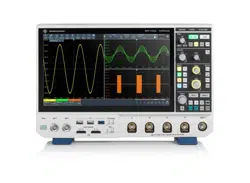Loading ...
Loading ...
Loading ...

Safety and regulatory information
R&S
®
MXO 4 Series
18User Manual 1335.5337.02 ─ 05
gory, the permitted category is indicated on the product and in the data sheet. If
you use other than Rohde & Schwarz accessories, make sure that they are suita-
ble for the instrument and the measurement task.
●
Set the correct attenuation factor on the instrument according to the probe being
used. Otherwise, the measurement results do not reflect the actual voltage level,
and you might misjudge the actual risk.
●
When working with high voltages and current probes, observe the additional oper-
ating conditions specified in these safety instructions.
●
The probe pins are extremely pointed and can easily penetrate clothes and the
skin. Handle the probe pins with great care. To exchange a probe pin, use tweez-
ers or pliers to avoid injuries. When transporting the accessories, always use the
box supplied with the probe.
●
Prevent the probe from receiving mechanical shock. Avoid putting excessive strain
on the probe cable or exposing it to sharp bends. Touching a broken cable during
measurements can cause injuries.
●
Set up all probe connections to the instrument before applying power.
Working with hazardous voltages
Voltages higher than 30 V RMS, or 42 V peak, or 60 V DC are regarded as hazardous
contact voltages. Direct contact with them can cause serious injuries.
Make sure that only electrically skilled persons use the products for measurements on
hazardous contact voltages. These working conditions require special education and
experience to perceive risks and to avoid hazards which electricity can create.
When working with hazardous contact voltages, use protective measures to preclude
direct contact with the measurement setup:
●
Do not touch exposed connections and components when power is applied.
●
Switch off the test circuit while connecting and disconnecting probe leads.
●
Use only insulated voltage probes, test leads and adapters.
●
Make sure that the input leads fulfill the safety requirements for your measurement.
The delivered input leads might have a jacket wear indicator that indicates a worn
jacket by different jacket color. In this case, do not use the input lead. Replace it
with a new one.
●
When connecting to the DUT, keep your fingers behind finger guard. Remove jew-
elry, watches, and other metallic objects. Only use 4 mm safety banana plugs.
Working with current probes
When working with current probes, you can measure high-frequency currents or cur-
rents that contain high-frequency components.
●
Switch off the test circuit while connecting the probe.
●
Do not attach the clamp to bare unisolated conductors. To avoid injury from a short
circuit, measure at a location on an insulated wire where the insulation is sufficient
for the circuit voltage.
●
Connect the probe only to the secondary side of a breaker. With this measure, you
avoid injury, if a short circuit occurs.
Safety instructions
Loading ...
Loading ...
Loading ...
